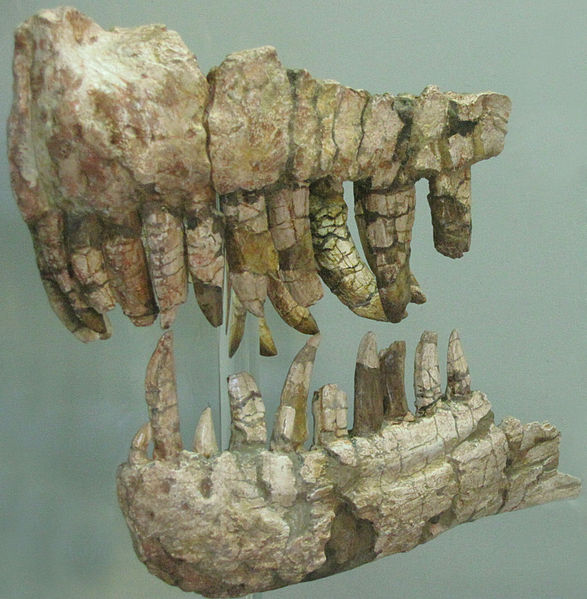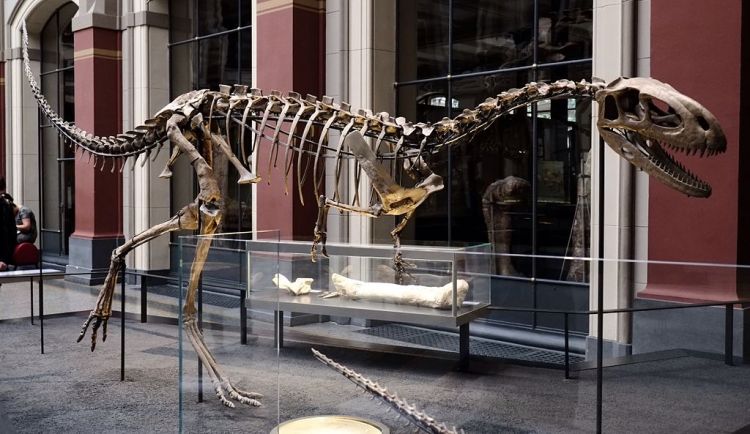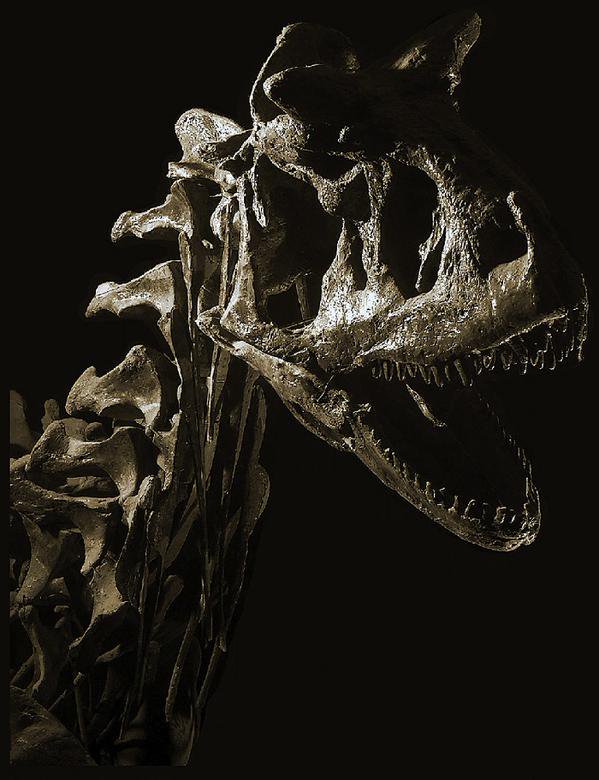
Snout of the ceratosaurian Genyodectes serus
In the last decades, the study of Gondwanan non-avian theropods has been highly prolific, showing that the group reached a great taxonomic and morphological diversity comparable to that of Laurasia. The Mesozoic Gondwanan neotheropod record includes: coelophysoids, basal averostrans, ceratosaurids, abelisauroids, megalosauroids, carcharodontosaurids, megaraptorans, basal coelurosaurs, compsognathids, alvarezsauroids, unenlagiids, and basal avialans, as well as putative tyrannosauroids, ornithomimosaur-like forms, and troodontid. Therefore, the Gondwanan fossil record has been crucial to understand the evolution and global biogeography of dinosaurs during the Mesozoic.
The first probable theropod remains from Gondwana were discovered in Colombia by Carl Degenhard, a German engineer, in 1839. At that time the word “dinosaur” did not even exist yet. Although Degenhard identified them as bird footprints, his brief description suggests that they were tracks of bipedal dinosaurs. But it was not until 1896 that the first Gondwanan theropod was named by the French palaeontologist Charles Depéret as “Megalosaurus” crenatissimus from the Upper Cretaceous of Madagascar. Several theropod remains were described from India, Africa, and South America during the 19th century. These early fragmentary discoveries lead the authors of the late XIX and early XX centuries to interpret them as belonging the same lineages present in Europe and North America.

Elaphrosaurus bambergi (Museum für Naturkunde 4960, holotype) from the Upper Jurassic of Tanzania (Janensch, 1920)
In 1901, A. Smith Woodward described Genyodectes, based on fragmentary skull bones, including portions of both maxillas, premaxillae, parts of the supradentaries, and some teeth, discovered by Santiago Roth in Chubut, at the end of the 1880s. Genyodectes remained as the most completely known theropod from South American until the 1970s. In 2004, O. Rauhut concluded that Genyodectes is more closely related to Ceratosaurus than the more derived abelisaurs.
Between 1915 and 1933, the most relevant Gondwanan theropod discoveries were produced by the work of the German palaeontologists Frederich von Huene, Ernst Stromer, and Werner Janensch, including for the first time the publication of very informative partial skeletons, such as those of Spinosaurus aegyptiacus and Elaphrosaurus bambergi (Stromer, 1915; Janensch, 1920). Despite its low fossil record, Spinosaurus is one of the most famous dinosaur of all time. This gigantic theropod possessed highly derived cranial and vertebral features sufficiently distinct for it to be designated as the nominal genus of the clade Spinosauridae. But during and after the Second World War the influence of the German palaeontology in the research of Gondwanan theropods abruptly declined.

Skull and neck of Carnotaurus sastrei
By the 1960s, the Argentine biologist Osvaldo Reig, together with Rodolfo Casamiquela and José Bonaparte, began to explore the Mesozoic rocks of Argentina looking for fossil tetrapods. In 1985, Bonaparte published a note presenting Carnotaurus sastrei as a new genus and species and briefly describing the skull and lower jaw. It was collected in the lower section of La Colonia Formation, Chubut Province. The discoveries of Bonaparte and his collaborators resulted in the recognition of the Patagonian theropod record as the most relevant and informative among Gondwanan continents. Some of the theropod species discovered in Patagonia are known on the basis of skulls and fairly complete skeletons offering insights into the anatomy and phylogeny of abelisaurids, carcharodontosaurids, and maniraptorans.
References:
Martín D. Ezcurra, and Federico L. Agnolín (2017). Gondwanan perspectives: Theropod dinosaurs from western Gondwana. A brief historical overview on the research of Mesozoic theropods in Gondwana. Ameghiniana 54: 483–487. Published By: Asociación Paleontológica Argentina https://doi.org/10.5710/102.054.0501
Novas, F.E., et al., Evolution of the carnivorous dinosaurs during the Cretaceous: The evidence from Patagonia, Cretaceous Research (2013), http://dx.doi.org/10.1016/j.cretres.2013.04.001
Buffetaut, E. 2000. A forgotten episode in the history of dinosaur ichnology; Carl Degenhardt’s report on the first discovery of fossil footprints in South America (Colombia, 1839). Bulletin de la Société Géologique de France 171: 137–140. Google Scholar
Pingback: Fossil Friday Roundup: December 1, 2017 | PLOS Paleo Community
Pingback: #89 nov17. Guerra a la Tierra Plana y a los creacionistas